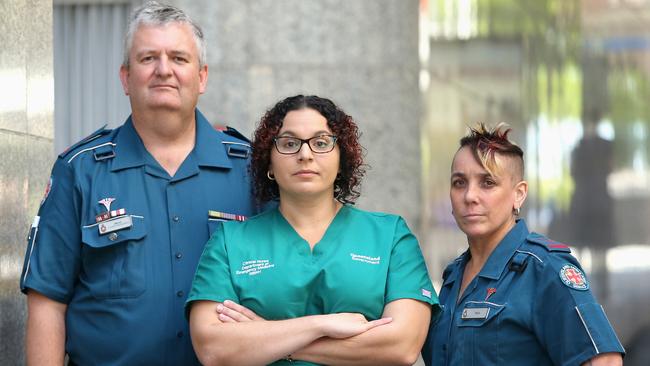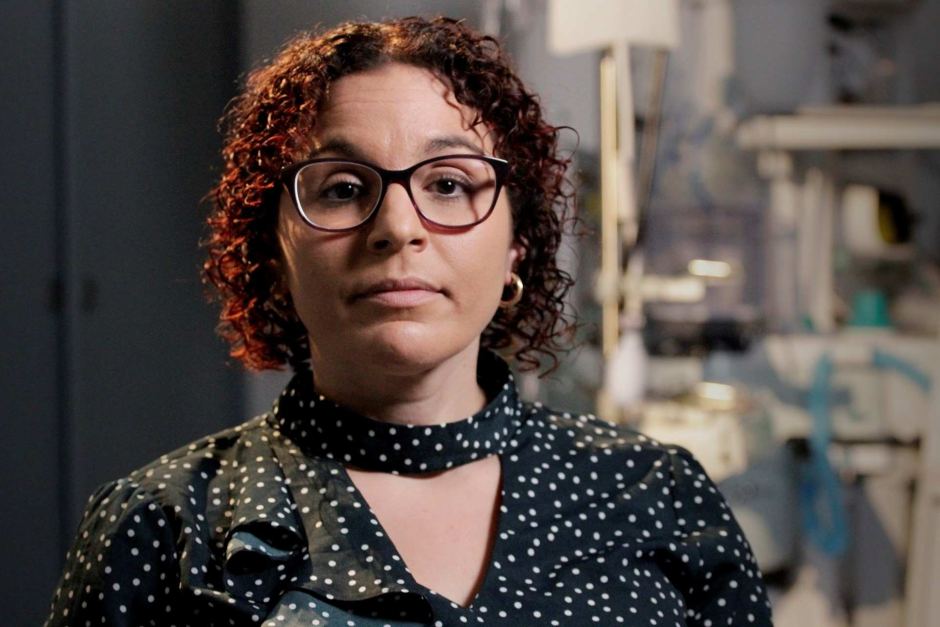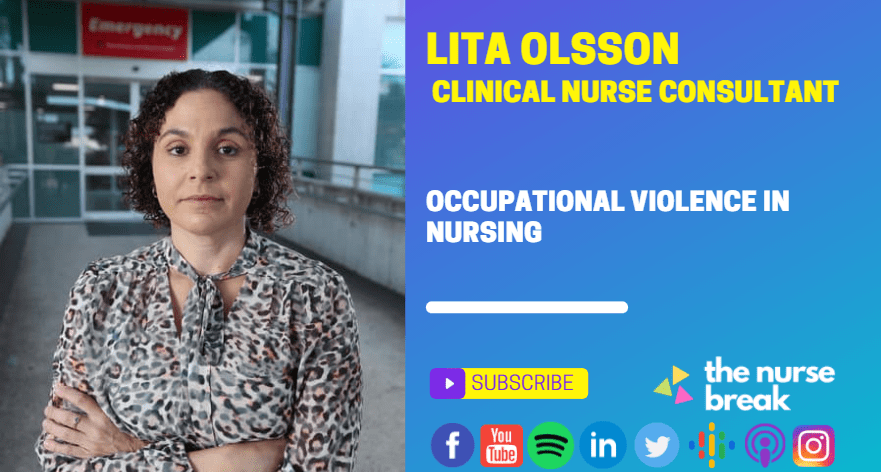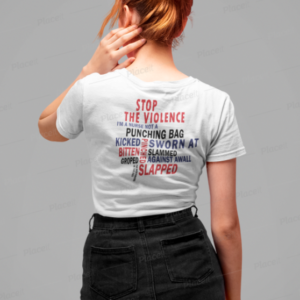Table of Contents
Meet Lita Olsson, a Clinical Nurse Consultant and Clinical Lead for the QLD Occupational Violence Strategy Unit, providing strategic oversight and clinical expertise to the implementation of a range of initiatives to reduce Occupational Violence.

Lita was 30 weeks pregnant when an intoxicated and disoriented middle-aged man struck her to the chest as she was carrying out routine nursing care. She has been nursing since 2004 in both the private and public sectors including in Emergency at the Royal Brisbane & Women’s Hospital.
The Nurse Break interview Lita in a panel discussion alongside a group of experts. Watch the Live Interview HERE
The Nurse Break’s mini-series on violence can be found HERE
Want to share your experiences of physical violence or write for us? Contact us
Introduction
I began my nursing career completely by accident. As a mature (ha!) aged student, I completed my Endorsed Enrolled Nursing diploma in 2004, and began working on a plastics and ENT ward while I completed my nursing degree. In 2007, I began my ED journey as a graduate nurse, where I specialised in Emergency Nursing until 2016. I was then offered the opportunity to undertake a health service-wide project on Occupational Violence. I am fluent in sarcasm; and am a mum, step mum, and fur mum.
What motivated you to become an advocate for staff safety?
I have had so many minor and not so minor exposures to occupational violence in my career. I’ve been sworn at, bitten, spat at, scratched, jumped on, and involved in situations where someone claimed to have a bomb strapped to their chest.
My worst incident was when I was punched in the stomach when I was about 30 weeks pregnant. I’ve also had to support staff who have sustained physical and psychological injuries from OV. After these really significant incidents, I started challenging how we actually manage these crisis situations.
Are we triaging appropriately? Are we missing the early warning signs? Should we just step back, instead of always running in?
Lita Olsson
Nurses don’t see risk the way our security officer colleagues do. We aren’t trained to know the signs. So, I partnered with one of our security officers and we created a “liaison role”. This role meant we could escalate concerns and cross-educate our teams on our roles and limitations. I spent a lot of time educating new staff to our ED on the different ways risk can manifest. As a nurse in charge of a shift in a tertiary ED, I needed to make sure my staff were as safe as they possibly could be.
How would you define ‘safety culture’ and what constitutes workplace violence?
That’s a really tough question. I don’t believe that any environment is without risk, so I would say that a safety culture is one where risk is identified, strategies are put in place to mitigate the risks, and there is no stigma associated.
Queensland Health has a very prescriptive, yet broad definition of occupational violence. It states “Occupational violence is any incident where an employee is abused, harassed, threatened or assaulted by patients and consumers, their relatives and friends or members of the public, in circumstances arising out of, or in the course of, their employment, irrespective of the intent for harm.”

What factors have contributed to the rise in violence in healthcare?
The causal factors aren’t new. They are what we have always known them to be. Fear, anxiety, pain, crisis, and many medical conditions contribute to aggression.
What areas of healthcare have seen the biggest increase in violent incidents?
I would have to say that the biggest increase we have seen, has been within dementia, delirium, and disability space. There has been a significant increase in younger, more agile patients with early-onset dementia, and younger patients with disabilities ending up in our acute health facilities.
Do you think the number of incidents reported is an accurate reflection of the true picture?
Oh hell no! We are just at the tip of the iceberg! Under-reporting of occupational violence is a global phenomenon.
Across Queensland, in the last year, we saw approximately 12,500 reported incidents of occupational violence. Yet on the other hand, we have seen nearly 95,000 occupational-violence related security interventions in the same timeframe. That’s about 13% of security interventions being reported by clinical staff.
Lita Olsson
What barriers might lead to underreporting of violent incidents?
Time. Time is a huge issue. We have already stretched nurses, in an overstretched system doing their best. But taking 15 minutes to complete an incident report every time they are sworn at, can be completely unachievable. What we do know, is that staff are more likely to report an incident is someone was injured or if they require time off.
What is the Occupational Violence Strategy unit?
QOVSU (the QLD Occ Violence Strategy Unit) was established in 2016, after a review into OV across Queensland Health after the tragic death of SA Nurse, Gayle Woodford. The taskforce report provided the government with 20 recommendations, which our unit was tasked with implementing.

Back then, we were a tiny team of 2, who networked with stakeholders from across the state. Our unit has since grown (slightly!), and we now have permanent funding. As of a couple of months ago, we are now a team of 7, and I remain the only clinician. Our focus now is on developing, trialling, evaluating and implementing strategies to reduce OV across all aspects of healthcare – just a small task.
How did your role as clinical lead for the occupational violence strategy come about?
I was working on the health service-wide OV project when our health service (Metro-North) was asked to take on the implementation of the recommendations from the Taskforce Report. I was lucky enough to transition into the role as the clinical lead for QOVSU.
What initiatives or projects has the unit developed or are currently working on?
Oh, there are stacks! For a tiny team, I am so proud of what we have achieved to date. Some of the initiatives we have implemented so far include:
- Ambassador Program based on the Canadian model, the Ambassador program uses non-traditional security officers in high risk clinical areas to proactively reduce OV through therapeutic and compassionate interactions with patients.
- Behaviour Modification Chart – a clinical tool with an escalation matrix that guides clinicians on how to appropriately escalate and manage changes in behaviours. The BMC uses the Broset Violence Checklist and the 6 key behavioural traits as as precursors to aggression.
- Unacceptable Behaviour Framework – a non-punitive framework that guides clinicians on how to discontinue care if there is imminent threat to staff, other patients or visitors.
- Occupational Violence Prevention training – Queensland Health conducted a review of training across the state, and transitioned to an evidence-based, least restrictive package that is biomechanically and breathability tested.
- “Respect Our Staff” poster campaign – using staff from across Queensland Health, QOVSU developed posters that highlighted that staff are more than their position. i.e. I am more than a nurse… I am also a dad, renovator, cook, camper. We also partnered with Queensland Ambulance Service and Breast Screen Queensland to develop posters for them.
- Clinical Insider Series – knowing that security officers come from all walks of life, most with no clinical training, we developed a suite of resources around some common medical conditions that may contribute to aggression, and how best to engage with them. To date, the series consists of factsheets on Dementia / Delirium, Autism Spectrum Disorder, Mental Health, Eating Disorders, and Brain Injury. There are more to come.. when we get time!
- Incident Response Kits – I am yet to meet a nurse who has ever been trained in how to support a staff member after an incident. Using the principles of psychological first aid, the kits step through how to provide first line support to your colleagues. Although originally printed as hard copies, we have since developed an icon that now sits on the desktop of ever QH computer, for easy access for staff right across the state.
- OV Risk Assessment tools – Standardised, evidence based, electronic tools are being rolled out.
- Security Officer training – we have partnered with Queensland Police Service lead negotiators who have been delivering negotiating and de-escalation training to our Security Officers across the state.
There is plenty more, but that’s the big stuff!
What do you enjoy most about your current role?
Oh where do I start?! I work with the most incredible, dedicate, passionate and knowledgeable team, who genuinely want to make a difference. It’s also the most unique nursing role, and I love the diversity of it.
What are the most challenging aspects of your work?
The political side of healthcare. I have learnt so much about the health system, but I also reflect on how difficult it can be on the frontline.
What strategies can healthcare staff employ to maintain or improve safety in the workplace?
Start challenging the way you do things in your clinical area. Could you be working smarter, not harder? Could you better your relationship with local security or clinical teams? Stand up, and be the person advocating for those without a voice. Support your colleagues. Report, report, report!
What resources are available to assist individuals to deal with workplace aggression/violence?
QOVSU has stacks of resources, and we are always happy to network and support other jurisdictions. Nurses should also check locally if there are strategies available that can be implemented.
What would be the title of your autobiography?
The Shit Magnet. ????????????
What do you envision for OVA prevention in 10 years from now?
Ooh, another tough one! I would love to see reporting is more proportionate to actual exposure of OV, I hope Security are embedded in clinical teams, and I truly hope clinicians feel safe to come to work and deliver exceptional healthcare to their community.
Across the board, we need proportionate funding, resources, and legislation to manage the risks associated with OV.
Lita olsson
Did you enjoy this article? If you are keen to write or you know someone who might be, email us! hello@thenursebreak.org






You must be logged in to post a comment.